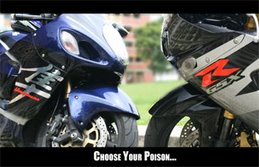
Every enthusiastic biker will at one point or another come across terms such as rake, trail and wheelbase.
These terms are used to describe the geometry of the bike, varying one or the other can dramatically affect the handling of the bike.
First we need to know what the terms actually refer to.
Wheelbase
This is the distance between the two points of contact with the ground by the bike (i.e. the tyres). Wheelbase affects the longitundal stability of the bike. Effectively a bike with shorter wheelbase has a tendency to wheelie or stoppie (given the weight of the rider remains constant).
Rake angle
This is angle measured from the the axis perpendicular to the ground to the steering axis ending at the centre of the wheel.
Trail
This is the angle measured from the contact of the wheel to the ground to the steering axis.
The following part is taken from an article by James R. Davis
We will look at two things that result from the fact that your front forks
are not pointing straight down - that is, there is a rake angle to those forks:
how counter-steering is initiated and how weave and wobble are diminished.
The diagram above represents your front tire pointing to the left. The
diagonal dashed line represents your steering stem as if it were extended to the
ground. Please note how this defines ground trail. (The diagram exaggerates how
far forward of the contact patch the steering axis point is for clarity.)
When you turn the handlebar you are attempting to turn the tire about the
steering axis at ground level, not about the contact patch. For example, if you
turn the handlebar to the right you are trying to get the tire to turn as shown
above. However, as the contact patch is touching the ground and the axis is not,
the contact patch CANNOT simply slide off to the left as shown. Instead, the
body of the motorcycle moves in that direction via force at the triple-tree. You
have, in effect, steered the front tire out from under the bike by steering the
bike away from the tire. [At a dead stop turn your handlebars all the way to the
right and observe how the top of the bike has moved to the right.]
As a result, gravity now tries to pull the bike down towards the left and
that drags the front wheel with it and our travel direction has begun moving to
the LEFT. (For the purists out there this is not arguing that gyroscopic
precession didn't play a part - only that because there is a rake angle
counter-steering would work even without gyroscopic precession.) [Note that
because of the huge difference in mass between the relatively light front-end
and the rest of the bike, when traveling at less than about 6 MPH you actually
CAN make a significant turn of the handlebars and there is not enough
centrifugal force to push the top of the bike away from the direction you are
pointing to. Instead, the bike falls INTO the turn at these slow speeds and THAT
is why counter-steering does not work at such slow speeds.]
Wobble and weave are diminished because when the wheel is pointing at an
angle other than straight ahead the contact patch is not in alignment with the
direction of travel of the bike - that is, a slip angle is created. A restoring
force is applied to the contact patch by the ground which attempts to force that
alignment. Thus, because of trail, the front wheel tries to go in a straight
line. [This restoring force, sometimes called a 'righting moment' or 'castor
effect', is a function of the length of trail. The longer the trail, the
stronger it is. It is also a function of traction. The higher the traction, the
stronger it is. Thus, braking increases the restoring force. This is primarily
what 'dumps' a bike when the front brake is applied during a slow speed
turn.]



